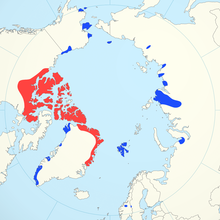
Back Muskusos Afrikaans የዝባድ በሬ Amharic ثور المسك Arabic ثور المسك ARZ Ovibos moschatus AST Rivebol (Ovibos moschatus) AVK Müşk öküzü Azerbaijani Аўцабык Byelorussian Овцебик Bulgarian Ejen-musk Breton
| Muskox Temporal range: Middle Pleistocene – Holocene
| |
|---|---|

| |
| in Dovrefjell National park, Norway | |
| Scientific classification | |
| Domain: | Eukaryota |
| Kingdom: | Animalia |
| Phylum: | Chordata |
| Class: | Mammalia |
| Order: | Artiodactyla |
| Family: | Bovidae |
| Subfamily: | Caprinae |
| Tribe: | Ovibovini |
| Genus: | Ovibos Blainville, 1816[3] |
| Species: | O. moschatus
|
| Binomial name | |
| Ovibos moschatus (Zimmermann, 1780)
| |

| |
| Range map: blue indicates areas where muskox reintroduction has been attempted in the 20th century; red indicates the previous established range. | |
| Synonyms[7] | |
|
Generic:
Specific: | |
The muskox (Ovibos moschatus, in Latin "musky sheep-ox"), also spelled musk ox and musk-ox, plural muskoxen or musk oxen (in Inuktitut: ᐅᒥᖕᒪᒃ, romanized: umingmak; in Woods Cree: ᒫᖨᒨᐢ, romanized: mâthi-môs, ᒫᖨᒧᐢᑐᐢ, mâthi-mostos), is a hoofed mammal of the family Bovidae.[8] Native to the Arctic, it is noted for its thick coat and for the strong odor emitted by males during the seasonal rut, from which its name derives. This musky odor has the effect of attracting females during mating season. Its Inuktitut name "umingmak" translates to "the bearded one".[9]
Its Woods Cree names "mâthi-môs" and "mâthi-mostos" translate to "ugly moose" and "ugly bison", respectively.[10] In historic times, muskoxen primarily lived in Greenland and the Canadian Arctic of the Northwest Territories and Nunavut,[11] They were formerly present in Eurasia, with their youngest natural records in the region dating to around 2,700 years ago,[12] with reintroduced populations in the American state of Alaska, the Canadian territory of Yukon, and Siberia, and an introduced population in Norway, part of which emigrated to Sweden, where a small population now lives.
- ^ Gunn, A.; Forchhammer, M. (2016) [errata version of 2008 assessment]. "Ovibos moschatus". IUCN Red List of Threatened Species. 2008: e.T29684A86066477. doi:10.2305/IUCN.UK.2008.RLTS.T29684A9526203.en. Retrieved 24 December 2019.
- ^ "Ovibos moschatus". NatureServe Explorer. Retrieved 17 April 2024.
- ^ de Blainville, M. H. (1816). "Sur plusieurs espèces d'animaux mammifères, de l'ordre des ruminans". Bulletin des Sciences Par la Société Philomathique de Paris. 1816: 76.
g. XI. Ovibos
- ^ Kowarzik, K. (1911). "Das Tränenbein von Ovibos moschatus Blainv". Zoologischer Anzeiger. 37: 106–107.
- ^ Zimmermann, E.A.W. (1780). "Der Muskusochse". Enthält ein vollständiges Verzeichnis aller bekannten Quadrupeden. Geographische Geschichte des Menschen, und der allgemein verbreiteten vierfüssigen Thiere. Vol. 2. Leipzig: Weygandschen Buchhandlung. pp. 86–88.
- ^ Raufuss, I., & von Koenigswald, W. (1999). New remains of Pleistocene Ovibos moschatus from Germany and its geographic and stratigraphic occurrence in Europe. Geologie en Mijnbouw, 78(3), 383-394.
- ^ Cite error: The named reference
Lent 1988was invoked but never defined (see the help page). - ^ Grubb, P. (2005). "Order Artiodactyla". In Wilson, D.E.; Reeder, D.M (eds.). Mammal Species of the World: A Taxonomic and Geographic Reference (3rd ed.). Johns Hopkins University Press. p. 707. ISBN 978-0-8018-8221-0. OCLC 62265494.
- ^ Flood, P. F.; Abrams, S. R.; Muir, G. D.; Rowell, J. E. (August 1989). "Odor of the muskox". Journal of Chemical Ecology. 15 (8): 2207–2217. Bibcode:1989JCEco..15.2207F. doi:10.1007/bf01014110. PMID 24272381. S2CID 8453835.
- ^ Houston, Clarence Stuart; Houston, Stuart; Ball, Tim; Houston, Mary (October 2003). Eighteenth-Century Naturalists of Hudson Bay. McGill-Queen's Press – MQUP. p. 241. ISBN 978-0-7735-2285-5.
- ^ Animal Life in Greenland – an introduction by the tourist board Archived 2012-04-27 at the Wayback Machine. Greenland-guide.gl. Retrieved on 2011-09-15.
- ^ Markova, A.K.; Puzachenko, A.Yu.; van Kolfschoten, T.; Kosintsev, P.A.; Kuznetsova, T.V.; Tikhonov, A.N.; Bachura, O.P.; Ponomarev, D.V.; van der Plicht, J.; Kuitems, M. (August 2015). "Changes in the Eurasian distribution of the musk ox (Ovibos moschatus) and the extinct bison (Bison priscus) during the last 50 ka BP". Quaternary International. 378: 99–110. Bibcode:2015QuInt.378...99M. doi:10.1016/j.quaint.2015.01.020. S2CID 140156564.

